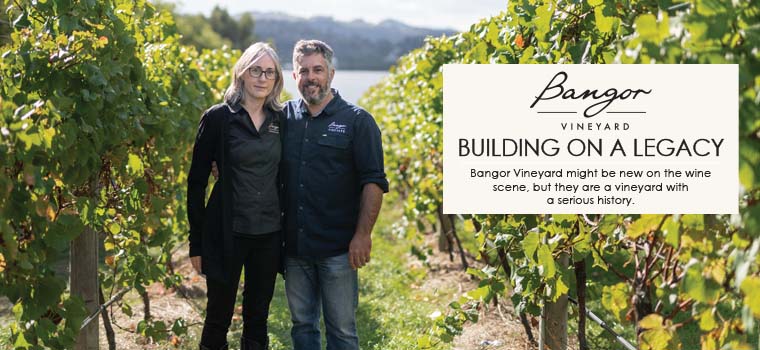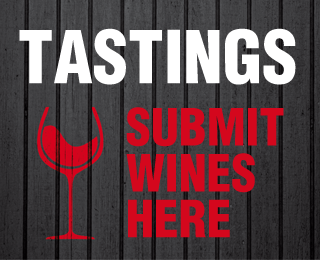Bangor Vineyard might be new on the wine scene, but they are a vineyard with a serious history.
"Rather than planting a range of different varieties, we have made a conscious decision to concentrate on the grapes that best fit our terroir. We get a long, slow ripening period here, good intensity of fruit flavours and an excellent level of natural acidity."
Winsor Dobbin
BANGOR Vineyard may be a relative newcomer on the Tasmanian premium wine scene, but the property has a long and fascinating history.
The Tasman Peninsula vineyard – around 45 minutes from Hobart – was first planted with vines in 2010, produced its first wines in 2014 and has quickly gained recognition for its sparkling wines, pinot noirs, chardonnays, and pinots gris, made in a range of styles.
The vineyard is planted on a historic 6,000-hectare property that is home to a sheep farm and forests that boast an impressive variety of Tasmanian plants, birds and mammals, including a large population of tumour-free Tasmanian devils.
Owners Matt and Vanessa Dunbabin use some of their wine profits to help protect and preserve the pristine environment and have a major sustainability focus.
Their cellar door overlooking the water at Dunalley is a major tourist attraction, open seven days for tastings and lunches. Guests can feast on oysters grown in the local waters and on lamb and wallaby from the family property. Zero food miles.
The Bangor Vineyard Shed has a dedicated wine tasting bar, private wine tasting room, and function spaces, along with a mini gourmet and souvenir store, and children’s playground with sand pit.
The building highlights timbers and stone from the property, and the facility has a stunning outlook over both Bangor Vineyard and Blackman Bay.
“Tasmania offers some of the best wine and food tourism experiences in the world and our continued development of Bangor Vineyard Shed reflects our optimism for the future of wine, tourism, and hospitality in our beautiful island state,” says Matt Dunbabin.
The property has been farmed since the 1830s – it once supplied beef to the Port Arthur Settlement.
It has over 5,100 hectares of native forests and wetlands, 35 kilometres of coastline and 2,100 hectares of private nature conservation reserve.
Bangor is carbon positive and uses solar power. “We store significantly more carbon every year than we emit; 1,500 tonnes more,” says Matt.
“We recently conducted a detailed carbon accounting across not only the wine business, but our entire property.
“We are always thinking about our environmental impact and how we can make positive changes.”
The vineyard is one of the most southerly in Tasmania, with the initial four hectares planted with pinot noir, pinot gris and chardonnay. There have been recent additional plantings – but no new varieties.
Well-drained clay loam soil over ancient dolerite rock, along with a gentle northerly aspect, provides a key quality building block and the maritime influence means that frost is not an issue, unlike in other parts of Tasmania.
“At a latitude of 42˚53′ south, Bangor’s vineyard is one of the most southerly in Tasmania, and the world,” says Dunbabin. “This makes it a true cool-climate site, and we carefully manage our vineyard to produce premium quality fruit.
“Rather than planting a range of different varieties, we have made a conscious decision to concentrate on the grapes that best fit our terroir. We get a long, slow ripening period here, good intensity of fruit flavours and an excellent level of natural acidity.
“We didn’t know a whole lot at the start, but each year we learn more about our site, and what it needs to thrive.”
Bangor has a fascinating history. It was on the northern shores of the farm that Dutch explorer Abel Tasman sent crew members to plant the Dutch flag 380 years ago.
The northern shoreline today looks almost identical as it did when Tasman and his men laid anchor in 1642 (there is a small memorial set back from the beach).
Members of the crew searched for fresh water and edible plants but found little of either and while they saw smoke they did not engage with the local indigenous people. They sailed north before heading to New Zealand.
Bangor’s history, of course, extends many thousands of years back, with the palawa people of lutruwita part of the oldest continuing culture in the world.
Six generations of Dunbabins, dating back to 1830, have farmed in this region, starting with convict John Dunbabin, who was deported from Britain after being found guilty of horse stealing.
The farm – owned by the family since 1890 – was once the site of three whaling stations. Matt and Vanessa are the current custodians, along with their three children.
While the Dunbabin family still runs sheep and cattle, the focus now is very much on the cool-climate Bangor wines, which are vinified by rising star in New Zealand-born Liam McElhinney and his team at Tasmanian Vintners.
“We are involved throughout the process and delighted with the wines that are being produced by Liam and his team,” says Matt. “We may be relative newcomers to the wine industry, but we have learnt a lot along the way, and we have some very good guides.”
To mark the links with Tasman, the vineyard’s first flagship wine was the 2014 Abel Tasman Pinot Noir.
Today there are three pinots in the range, the entry-level Captain Spotswood, the Abel Tasman, and the Reserve, along with the award-winning Maria rosé.
The reserve pinot is made only in outstanding vintages and exceptional small parcels are sometimes used to produce individual vineyard wines. “We do little runs – like a barrel-aged pinot gris that has proved popular but is made in tiny quantities,” says Matt.
Bangor Vineyard Shed, 20 Blackman Bay Road, Dunalley, 7177, Tasmania. www.bangorshed.com.au
THE BANGER VINEYARD SHED is one of several gourmet attractions in the region, many of them members of the fledgling Tasman Wine and Spirits tourist trail.
Other wineries in the Tasman Peninsula region include Bream Creek (with a cellar door on the way), Cape Bernier and Sugarloaf Ridge.
Spirits producers McHenry Distillers, Hellfire Bluff, Impression Bay Distillery and Nonesuch all welcome visitors, as do Blue Lagoon Oysters.
Eating options other than the Bangor Shed include The Cannery at Dunalley and Van Bone at Marion Bay.
“The entire region is a fabulous place for food lovers,” says Matt Dunbabin. “A vast majority of the produce we use in our restaurant comes from farms and waterways within a few kilometres. We love the paddock-to-plate ethos.”
Think dishes like Local Tongola Farm curdy, Burnside extra virgin olive oil, creamed honey, fennel crunch and house-made lavosh; or perhaps glazed Bangor lamb ribs, whipped feta, harissa jam and hazelnut dukkah.
For those who want to arrive in style, Par Avion can also operate scenic helicopter flights directly to Bangor Shed, with a leisurely lunch included.
www.tasmanwinespiritstrail.com





